COIT 20252: Business Process Management Case Study Report Analysis
VerifiedAdded on 2023/01/05
|24
|6689
|23
Report
AI Summary
This report provides a detailed analysis of a Business Process Management (BPM) case study centered on a construction company, referred to as Company A. The report explores the critical need for business process improvement, examines organizational maturity using CMM, and delves into business process modeling and analysis, including the 'as-is' and 'to-be' processes. It also addresses continuous process improvement strategies. The case study highlights the challenges and opportunities in streamlining processes, improving efficiency, and achieving a competitive edge within the construction industry. The report covers various aspects of BPM, including requirements, advantages, and the connection between BPM and BPR. It also discusses the different levels of CMM and their impact on the company's processes. Furthermore, it analyzes the outcomes of process analysis, problem areas, and the approach to process modeling, as well as the complications in improvement activities and factors for critical success. The report aims to provide insights into the practical application of BPM principles within a construction context, offering valuable lessons and recommendations for enhancing business performance.
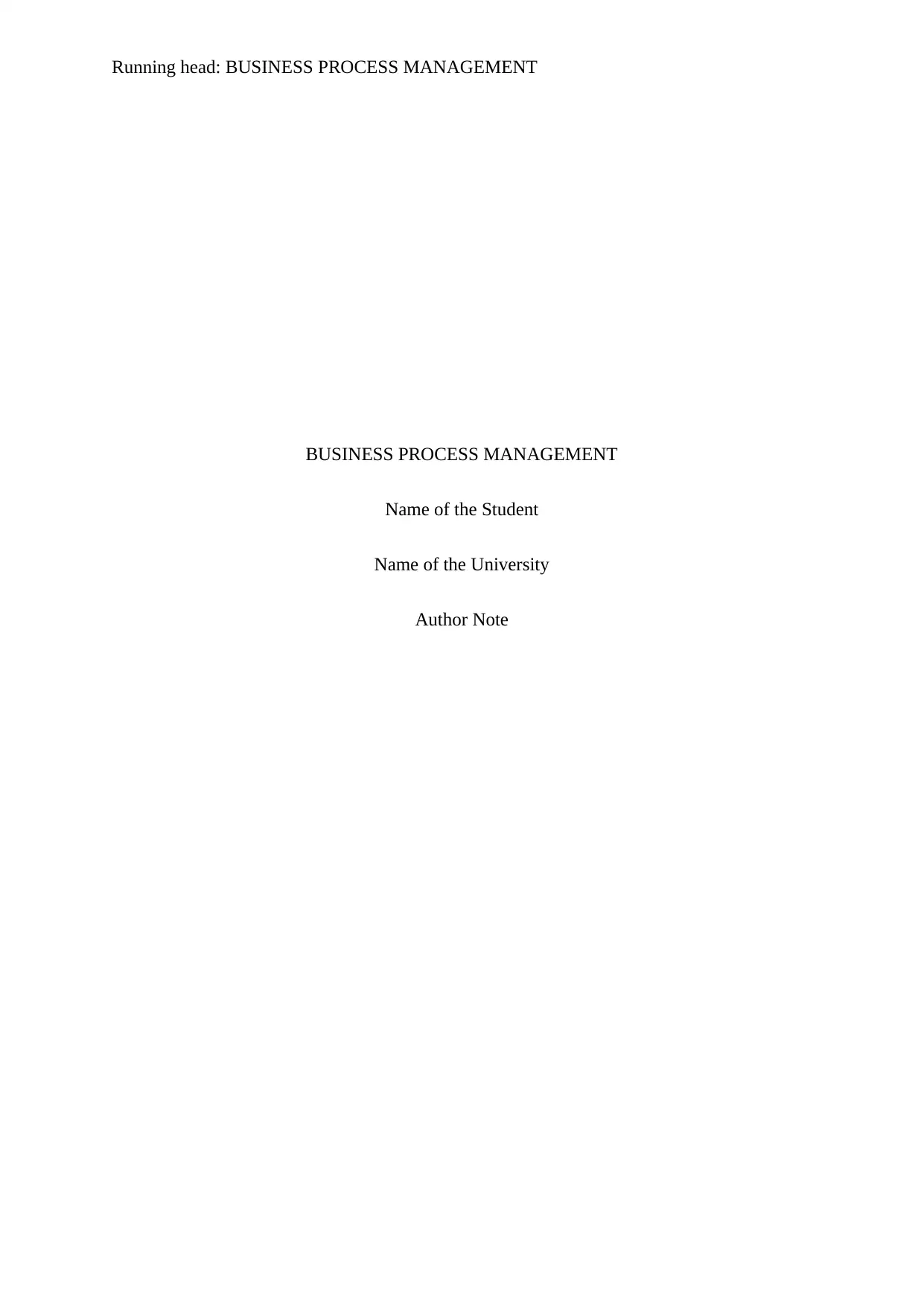
Running head: BUSINESS PROCESS MANAGEMENT
BUSINESS PROCESS MANAGEMENT
Name of the Student
Name of the University
Author Note
BUSINESS PROCESS MANAGEMENT
Name of the Student
Name of the University
Author Note
Paraphrase This Document
Need a fresh take? Get an instant paraphrase of this document with our AI Paraphraser
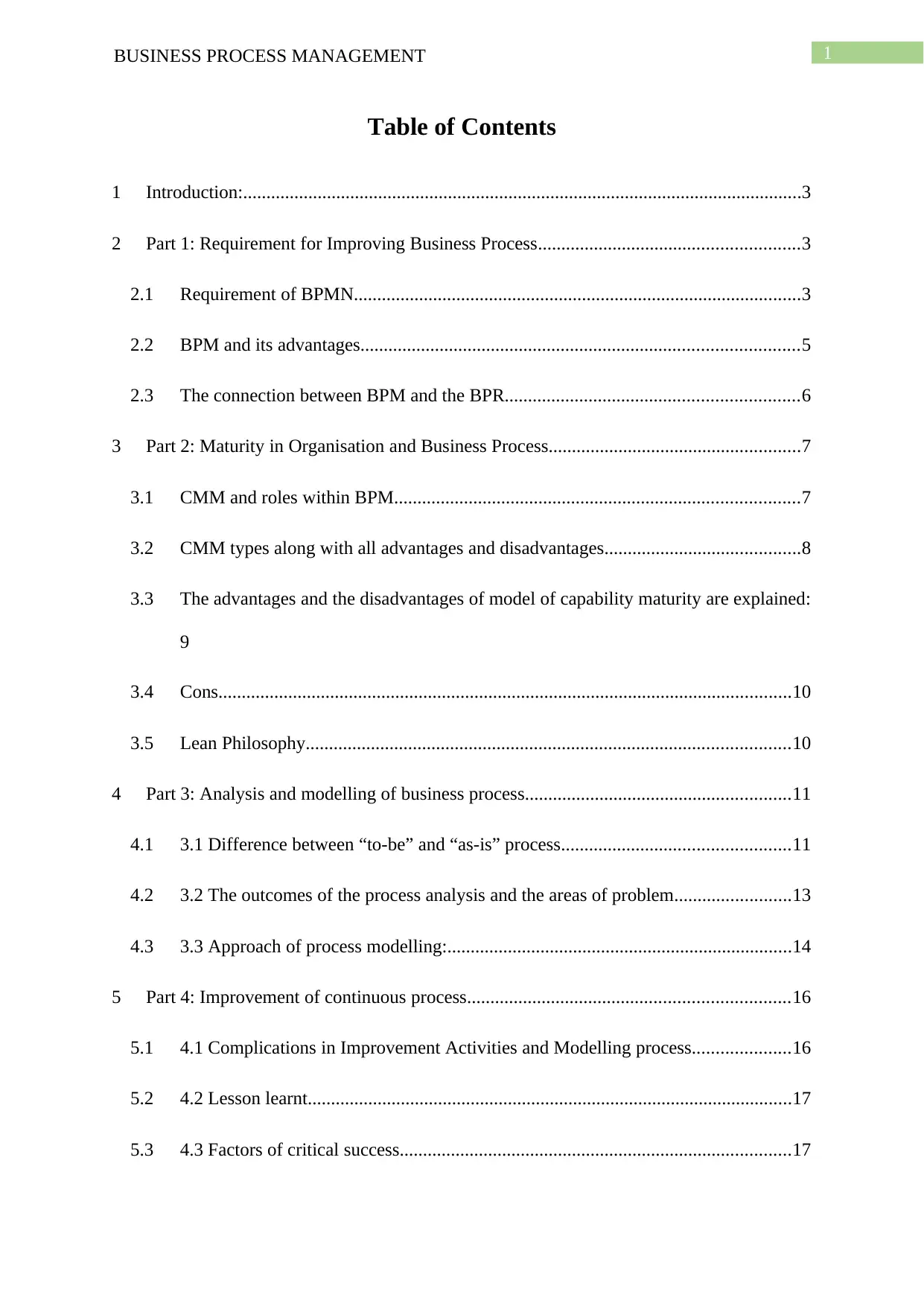
BUSINESS PROCESS MANAGEMENT 1
Table of Contents
1 Introduction:........................................................................................................................3
2 Part 1: Requirement for Improving Business Process........................................................3
2.1 Requirement of BPMN................................................................................................3
2.2 BPM and its advantages..............................................................................................5
2.3 The connection between BPM and the BPR...............................................................6
3 Part 2: Maturity in Organisation and Business Process......................................................7
3.1 CMM and roles within BPM.......................................................................................7
3.2 CMM types along with all advantages and disadvantages..........................................8
3.3 The advantages and the disadvantages of model of capability maturity are explained:
9
3.4 Cons...........................................................................................................................10
3.5 Lean Philosophy........................................................................................................10
4 Part 3: Analysis and modelling of business process.........................................................11
4.1 3.1 Difference between “to-be” and “as-is” process.................................................11
4.2 3.2 The outcomes of the process analysis and the areas of problem.........................13
4.3 3.3 Approach of process modelling:..........................................................................14
5 Part 4: Improvement of continuous process.....................................................................16
5.1 4.1 Complications in Improvement Activities and Modelling process.....................16
5.2 4.2 Lesson learnt........................................................................................................17
5.3 4.3 Factors of critical success....................................................................................17
Table of Contents
1 Introduction:........................................................................................................................3
2 Part 1: Requirement for Improving Business Process........................................................3
2.1 Requirement of BPMN................................................................................................3
2.2 BPM and its advantages..............................................................................................5
2.3 The connection between BPM and the BPR...............................................................6
3 Part 2: Maturity in Organisation and Business Process......................................................7
3.1 CMM and roles within BPM.......................................................................................7
3.2 CMM types along with all advantages and disadvantages..........................................8
3.3 The advantages and the disadvantages of model of capability maturity are explained:
9
3.4 Cons...........................................................................................................................10
3.5 Lean Philosophy........................................................................................................10
4 Part 3: Analysis and modelling of business process.........................................................11
4.1 3.1 Difference between “to-be” and “as-is” process.................................................11
4.2 3.2 The outcomes of the process analysis and the areas of problem.........................13
4.3 3.3 Approach of process modelling:..........................................................................14
5 Part 4: Improvement of continuous process.....................................................................16
5.1 4.1 Complications in Improvement Activities and Modelling process.....................16
5.2 4.2 Lesson learnt........................................................................................................17
5.3 4.3 Factors of critical success....................................................................................17

2BUSINESS PROCESS MANAGEMENT
6 Conclusion:.......................................................................................................................18
7 References:........................................................................................................................20
6 Conclusion:.......................................................................................................................18
7 References:........................................................................................................................20
⊘ This is a preview!⊘
Do you want full access?
Subscribe today to unlock all pages.

Trusted by 1+ million students worldwide
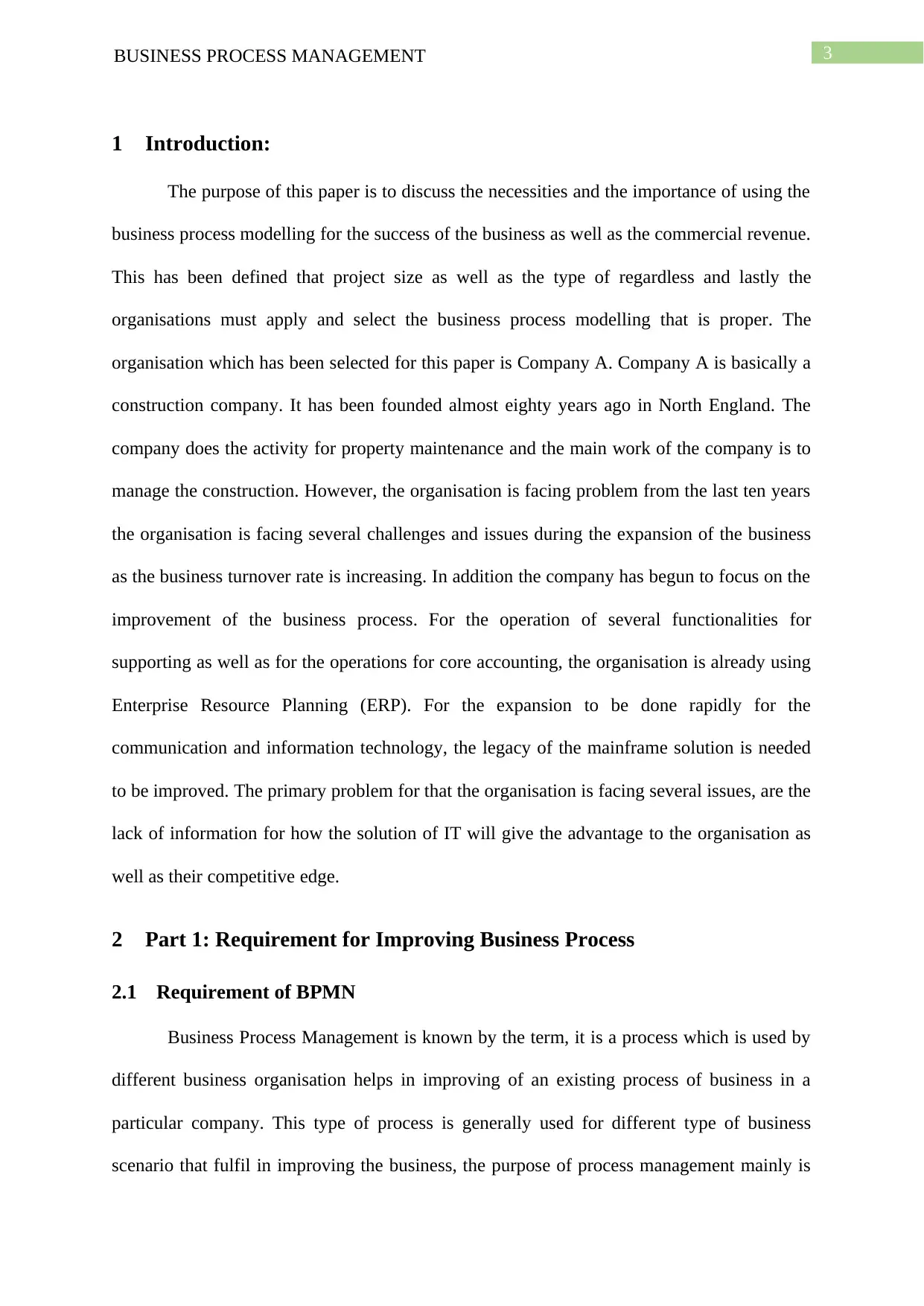
3BUSINESS PROCESS MANAGEMENT
1 Introduction:
The purpose of this paper is to discuss the necessities and the importance of using the
business process modelling for the success of the business as well as the commercial revenue.
This has been defined that project size as well as the type of regardless and lastly the
organisations must apply and select the business process modelling that is proper. The
organisation which has been selected for this paper is Company A. Company A is basically a
construction company. It has been founded almost eighty years ago in North England. The
company does the activity for property maintenance and the main work of the company is to
manage the construction. However, the organisation is facing problem from the last ten years
the organisation is facing several challenges and issues during the expansion of the business
as the business turnover rate is increasing. In addition the company has begun to focus on the
improvement of the business process. For the operation of several functionalities for
supporting as well as for the operations for core accounting, the organisation is already using
Enterprise Resource Planning (ERP). For the expansion to be done rapidly for the
communication and information technology, the legacy of the mainframe solution is needed
to be improved. The primary problem for that the organisation is facing several issues, are the
lack of information for how the solution of IT will give the advantage to the organisation as
well as their competitive edge.
2 Part 1: Requirement for Improving Business Process
2.1 Requirement of BPMN
Business Process Management is known by the term, it is a process which is used by
different business organisation helps in improving of an existing process of business in a
particular company. This type of process is generally used for different type of business
scenario that fulfil in improving the business, the purpose of process management mainly is
1 Introduction:
The purpose of this paper is to discuss the necessities and the importance of using the
business process modelling for the success of the business as well as the commercial revenue.
This has been defined that project size as well as the type of regardless and lastly the
organisations must apply and select the business process modelling that is proper. The
organisation which has been selected for this paper is Company A. Company A is basically a
construction company. It has been founded almost eighty years ago in North England. The
company does the activity for property maintenance and the main work of the company is to
manage the construction. However, the organisation is facing problem from the last ten years
the organisation is facing several challenges and issues during the expansion of the business
as the business turnover rate is increasing. In addition the company has begun to focus on the
improvement of the business process. For the operation of several functionalities for
supporting as well as for the operations for core accounting, the organisation is already using
Enterprise Resource Planning (ERP). For the expansion to be done rapidly for the
communication and information technology, the legacy of the mainframe solution is needed
to be improved. The primary problem for that the organisation is facing several issues, are the
lack of information for how the solution of IT will give the advantage to the organisation as
well as their competitive edge.
2 Part 1: Requirement for Improving Business Process
2.1 Requirement of BPMN
Business Process Management is known by the term, it is a process which is used by
different business organisation helps in improving of an existing process of business in a
particular company. This type of process is generally used for different type of business
scenario that fulfil in improving the business, the purpose of process management mainly is
Paraphrase This Document
Need a fresh take? Get an instant paraphrase of this document with our AI Paraphraser
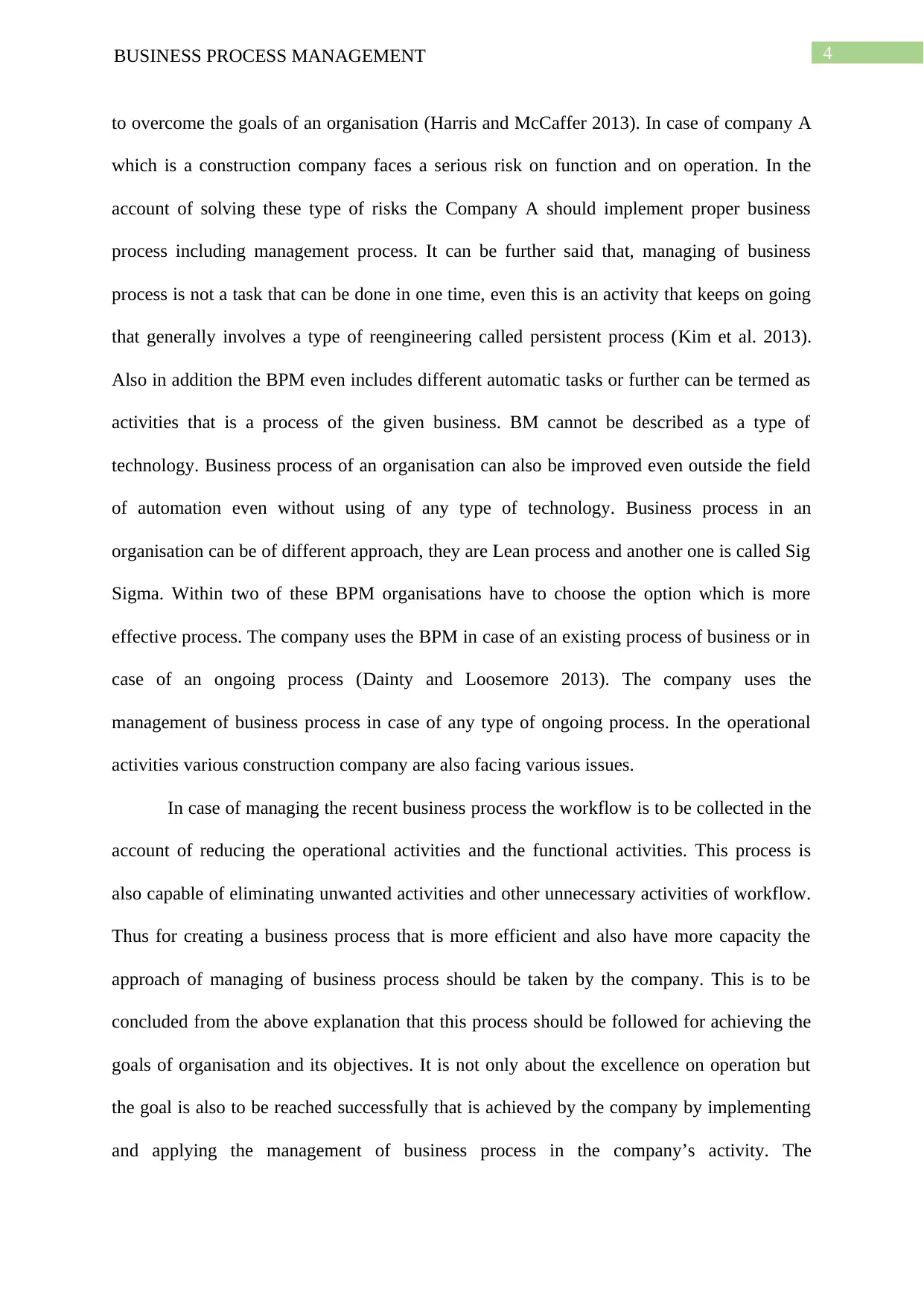
4BUSINESS PROCESS MANAGEMENT
to overcome the goals of an organisation (Harris and McCaffer 2013). In case of company A
which is a construction company faces a serious risk on function and on operation. In the
account of solving these type of risks the Company A should implement proper business
process including management process. It can be further said that, managing of business
process is not a task that can be done in one time, even this is an activity that keeps on going
that generally involves a type of reengineering called persistent process (Kim et al. 2013).
Also in addition the BPM even includes different automatic tasks or further can be termed as
activities that is a process of the given business. BM cannot be described as a type of
technology. Business process of an organisation can also be improved even outside the field
of automation even without using of any type of technology. Business process in an
organisation can be of different approach, they are Lean process and another one is called Sig
Sigma. Within two of these BPM organisations have to choose the option which is more
effective process. The company uses the BPM in case of an existing process of business or in
case of an ongoing process (Dainty and Loosemore 2013). The company uses the
management of business process in case of any type of ongoing process. In the operational
activities various construction company are also facing various issues.
In case of managing the recent business process the workflow is to be collected in the
account of reducing the operational activities and the functional activities. This process is
also capable of eliminating unwanted activities and other unnecessary activities of workflow.
Thus for creating a business process that is more efficient and also have more capacity the
approach of managing of business process should be taken by the company. This is to be
concluded from the above explanation that this process should be followed for achieving the
goals of organisation and its objectives. It is not only about the excellence on operation but
the goal is also to be reached successfully that is achieved by the company by implementing
and applying the management of business process in the company’s activity. The
to overcome the goals of an organisation (Harris and McCaffer 2013). In case of company A
which is a construction company faces a serious risk on function and on operation. In the
account of solving these type of risks the Company A should implement proper business
process including management process. It can be further said that, managing of business
process is not a task that can be done in one time, even this is an activity that keeps on going
that generally involves a type of reengineering called persistent process (Kim et al. 2013).
Also in addition the BPM even includes different automatic tasks or further can be termed as
activities that is a process of the given business. BM cannot be described as a type of
technology. Business process of an organisation can also be improved even outside the field
of automation even without using of any type of technology. Business process in an
organisation can be of different approach, they are Lean process and another one is called Sig
Sigma. Within two of these BPM organisations have to choose the option which is more
effective process. The company uses the BPM in case of an existing process of business or in
case of an ongoing process (Dainty and Loosemore 2013). The company uses the
management of business process in case of any type of ongoing process. In the operational
activities various construction company are also facing various issues.
In case of managing the recent business process the workflow is to be collected in the
account of reducing the operational activities and the functional activities. This process is
also capable of eliminating unwanted activities and other unnecessary activities of workflow.
Thus for creating a business process that is more efficient and also have more capacity the
approach of managing of business process should be taken by the company. This is to be
concluded from the above explanation that this process should be followed for achieving the
goals of organisation and its objectives. It is not only about the excellence on operation but
the goal is also to be reached successfully that is achieved by the company by implementing
and applying the management of business process in the company’s activity. The
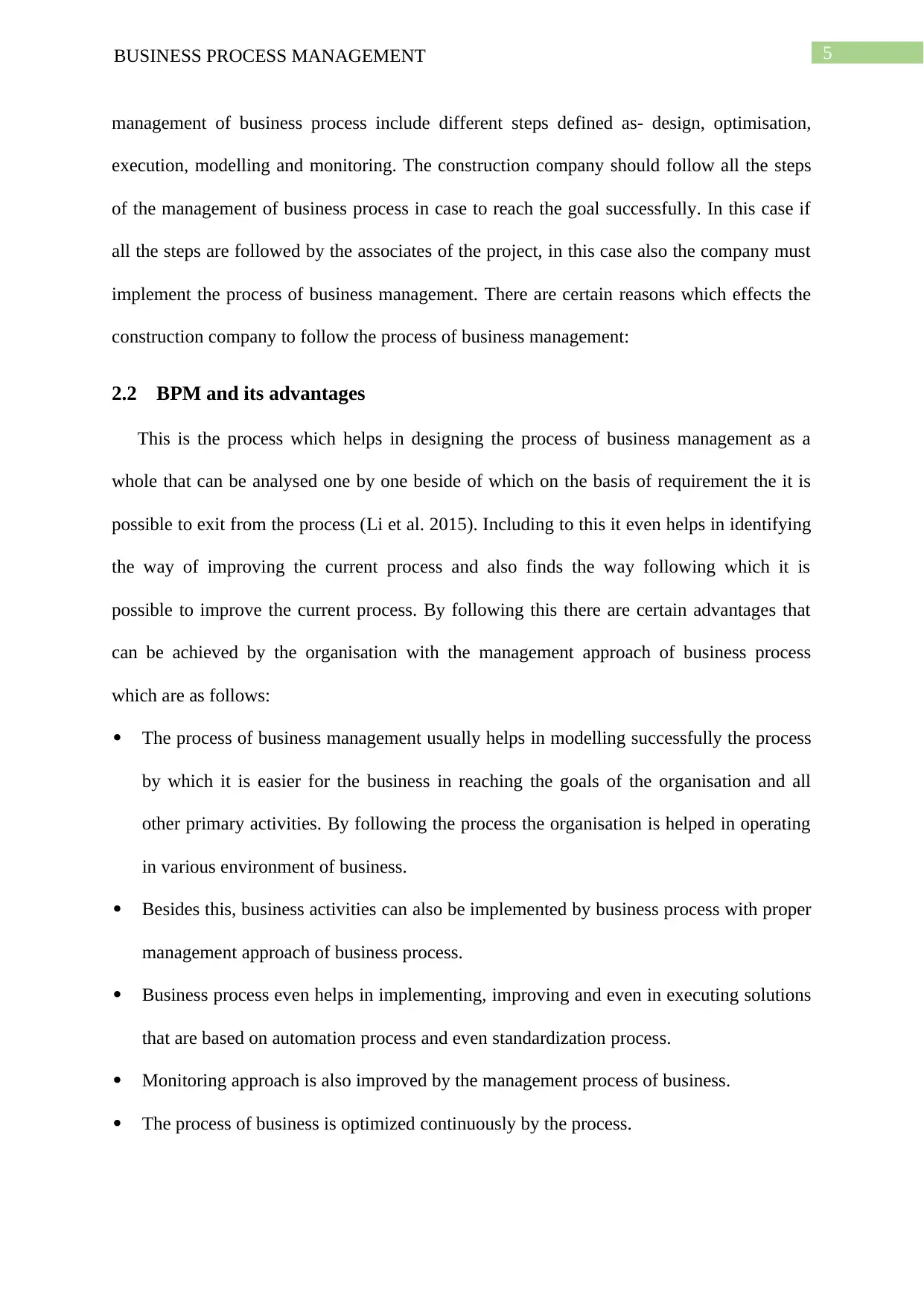
5BUSINESS PROCESS MANAGEMENT
management of business process include different steps defined as- design, optimisation,
execution, modelling and monitoring. The construction company should follow all the steps
of the management of business process in case to reach the goal successfully. In this case if
all the steps are followed by the associates of the project, in this case also the company must
implement the process of business management. There are certain reasons which effects the
construction company to follow the process of business management:
2.2 BPM and its advantages
This is the process which helps in designing the process of business management as a
whole that can be analysed one by one beside of which on the basis of requirement the it is
possible to exit from the process (Li et al. 2015). Including to this it even helps in identifying
the way of improving the current process and also finds the way following which it is
possible to improve the current process. By following this there are certain advantages that
can be achieved by the organisation with the management approach of business process
which are as follows:
The process of business management usually helps in modelling successfully the process
by which it is easier for the business in reaching the goals of the organisation and all
other primary activities. By following the process the organisation is helped in operating
in various environment of business.
Besides this, business activities can also be implemented by business process with proper
management approach of business process.
Business process even helps in implementing, improving and even in executing solutions
that are based on automation process and even standardization process.
Monitoring approach is also improved by the management process of business.
The process of business is optimized continuously by the process.
management of business process include different steps defined as- design, optimisation,
execution, modelling and monitoring. The construction company should follow all the steps
of the management of business process in case to reach the goal successfully. In this case if
all the steps are followed by the associates of the project, in this case also the company must
implement the process of business management. There are certain reasons which effects the
construction company to follow the process of business management:
2.2 BPM and its advantages
This is the process which helps in designing the process of business management as a
whole that can be analysed one by one beside of which on the basis of requirement the it is
possible to exit from the process (Li et al. 2015). Including to this it even helps in identifying
the way of improving the current process and also finds the way following which it is
possible to improve the current process. By following this there are certain advantages that
can be achieved by the organisation with the management approach of business process
which are as follows:
The process of business management usually helps in modelling successfully the process
by which it is easier for the business in reaching the goals of the organisation and all
other primary activities. By following the process the organisation is helped in operating
in various environment of business.
Besides this, business activities can also be implemented by business process with proper
management approach of business process.
Business process even helps in implementing, improving and even in executing solutions
that are based on automation process and even standardization process.
Monitoring approach is also improved by the management process of business.
The process of business is optimized continuously by the process.
⊘ This is a preview!⊘
Do you want full access?
Subscribe today to unlock all pages.

Trusted by 1+ million students worldwide
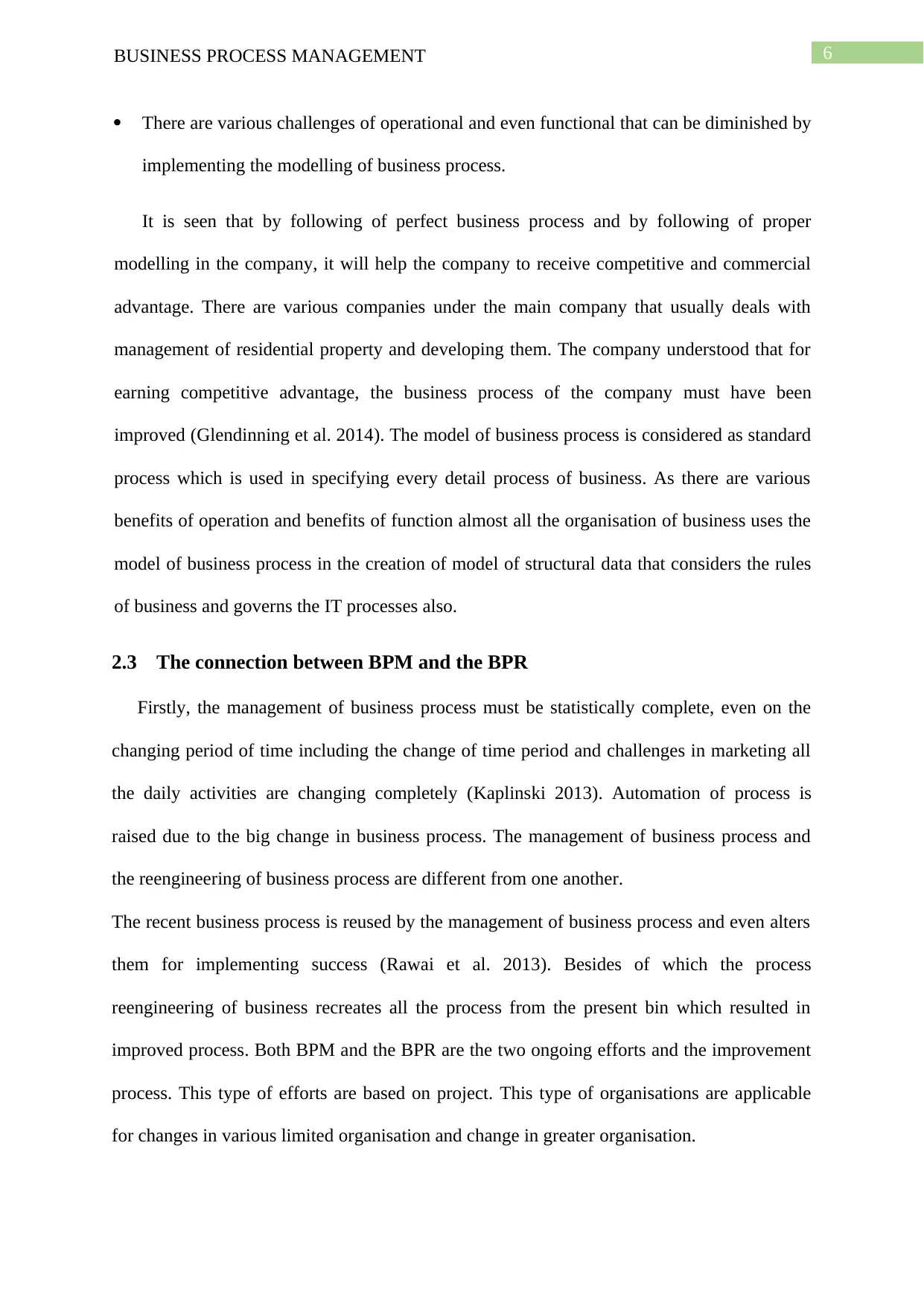
6BUSINESS PROCESS MANAGEMENT
There are various challenges of operational and even functional that can be diminished by
implementing the modelling of business process.
It is seen that by following of perfect business process and by following of proper
modelling in the company, it will help the company to receive competitive and commercial
advantage. There are various companies under the main company that usually deals with
management of residential property and developing them. The company understood that for
earning competitive advantage, the business process of the company must have been
improved (Glendinning et al. 2014). The model of business process is considered as standard
process which is used in specifying every detail process of business. As there are various
benefits of operation and benefits of function almost all the organisation of business uses the
model of business process in the creation of model of structural data that considers the rules
of business and governs the IT processes also.
2.3 The connection between BPM and the BPR
Firstly, the management of business process must be statistically complete, even on the
changing period of time including the change of time period and challenges in marketing all
the daily activities are changing completely (Kaplinski 2013). Automation of process is
raised due to the big change in business process. The management of business process and
the reengineering of business process are different from one another.
The recent business process is reused by the management of business process and even alters
them for implementing success (Rawai et al. 2013). Besides of which the process
reengineering of business recreates all the process from the present bin which resulted in
improved process. Both BPM and the BPR are the two ongoing efforts and the improvement
process. This type of efforts are based on project. This type of organisations are applicable
for changes in various limited organisation and change in greater organisation.
There are various challenges of operational and even functional that can be diminished by
implementing the modelling of business process.
It is seen that by following of perfect business process and by following of proper
modelling in the company, it will help the company to receive competitive and commercial
advantage. There are various companies under the main company that usually deals with
management of residential property and developing them. The company understood that for
earning competitive advantage, the business process of the company must have been
improved (Glendinning et al. 2014). The model of business process is considered as standard
process which is used in specifying every detail process of business. As there are various
benefits of operation and benefits of function almost all the organisation of business uses the
model of business process in the creation of model of structural data that considers the rules
of business and governs the IT processes also.
2.3 The connection between BPM and the BPR
Firstly, the management of business process must be statistically complete, even on the
changing period of time including the change of time period and challenges in marketing all
the daily activities are changing completely (Kaplinski 2013). Automation of process is
raised due to the big change in business process. The management of business process and
the reengineering of business process are different from one another.
The recent business process is reused by the management of business process and even alters
them for implementing success (Rawai et al. 2013). Besides of which the process
reengineering of business recreates all the process from the present bin which resulted in
improved process. Both BPM and the BPR are the two ongoing efforts and the improvement
process. This type of efforts are based on project. This type of organisations are applicable
for changes in various limited organisation and change in greater organisation.
Paraphrase This Document
Need a fresh take? Get an instant paraphrase of this document with our AI Paraphraser
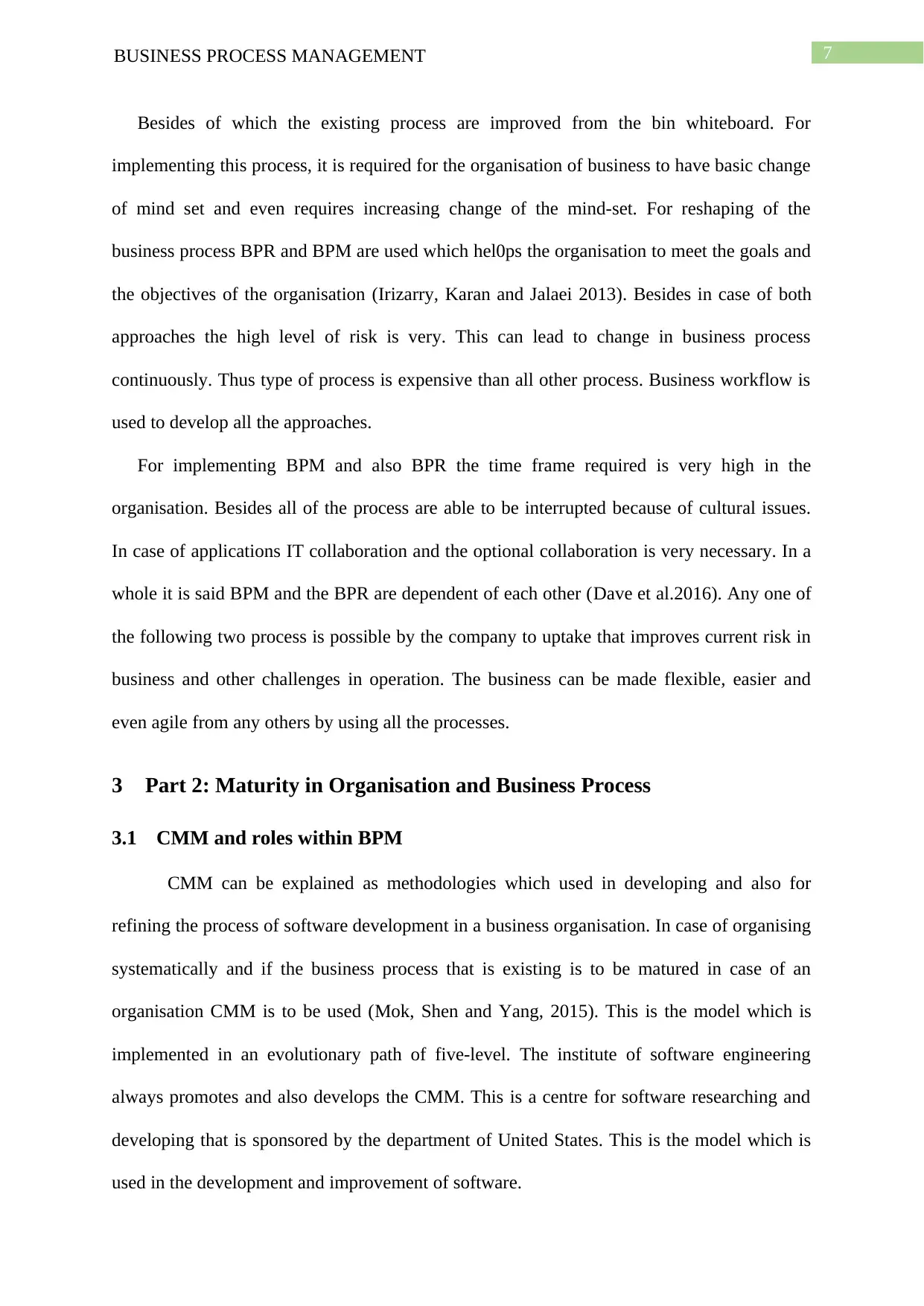
7BUSINESS PROCESS MANAGEMENT
Besides of which the existing process are improved from the bin whiteboard. For
implementing this process, it is required for the organisation of business to have basic change
of mind set and even requires increasing change of the mind-set. For reshaping of the
business process BPR and BPM are used which hel0ps the organisation to meet the goals and
the objectives of the organisation (Irizarry, Karan and Jalaei 2013). Besides in case of both
approaches the high level of risk is very. This can lead to change in business process
continuously. Thus type of process is expensive than all other process. Business workflow is
used to develop all the approaches.
For implementing BPM and also BPR the time frame required is very high in the
organisation. Besides all of the process are able to be interrupted because of cultural issues.
In case of applications IT collaboration and the optional collaboration is very necessary. In a
whole it is said BPM and the BPR are dependent of each other (Dave et al.2016). Any one of
the following two process is possible by the company to uptake that improves current risk in
business and other challenges in operation. The business can be made flexible, easier and
even agile from any others by using all the processes.
3 Part 2: Maturity in Organisation and Business Process
3.1 CMM and roles within BPM
CMM can be explained as methodologies which used in developing and also for
refining the process of software development in a business organisation. In case of organising
systematically and if the business process that is existing is to be matured in case of an
organisation CMM is to be used (Mok, Shen and Yang, 2015). This is the model which is
implemented in an evolutionary path of five-level. The institute of software engineering
always promotes and also develops the CMM. This is a centre for software researching and
developing that is sponsored by the department of United States. This is the model which is
used in the development and improvement of software.
Besides of which the existing process are improved from the bin whiteboard. For
implementing this process, it is required for the organisation of business to have basic change
of mind set and even requires increasing change of the mind-set. For reshaping of the
business process BPR and BPM are used which hel0ps the organisation to meet the goals and
the objectives of the organisation (Irizarry, Karan and Jalaei 2013). Besides in case of both
approaches the high level of risk is very. This can lead to change in business process
continuously. Thus type of process is expensive than all other process. Business workflow is
used to develop all the approaches.
For implementing BPM and also BPR the time frame required is very high in the
organisation. Besides all of the process are able to be interrupted because of cultural issues.
In case of applications IT collaboration and the optional collaboration is very necessary. In a
whole it is said BPM and the BPR are dependent of each other (Dave et al.2016). Any one of
the following two process is possible by the company to uptake that improves current risk in
business and other challenges in operation. The business can be made flexible, easier and
even agile from any others by using all the processes.
3 Part 2: Maturity in Organisation and Business Process
3.1 CMM and roles within BPM
CMM can be explained as methodologies which used in developing and also for
refining the process of software development in a business organisation. In case of organising
systematically and if the business process that is existing is to be matured in case of an
organisation CMM is to be used (Mok, Shen and Yang, 2015). This is the model which is
implemented in an evolutionary path of five-level. The institute of software engineering
always promotes and also develops the CMM. This is a centre for software researching and
developing that is sponsored by the department of United States. This is the model which is
used in the development and improvement of software.
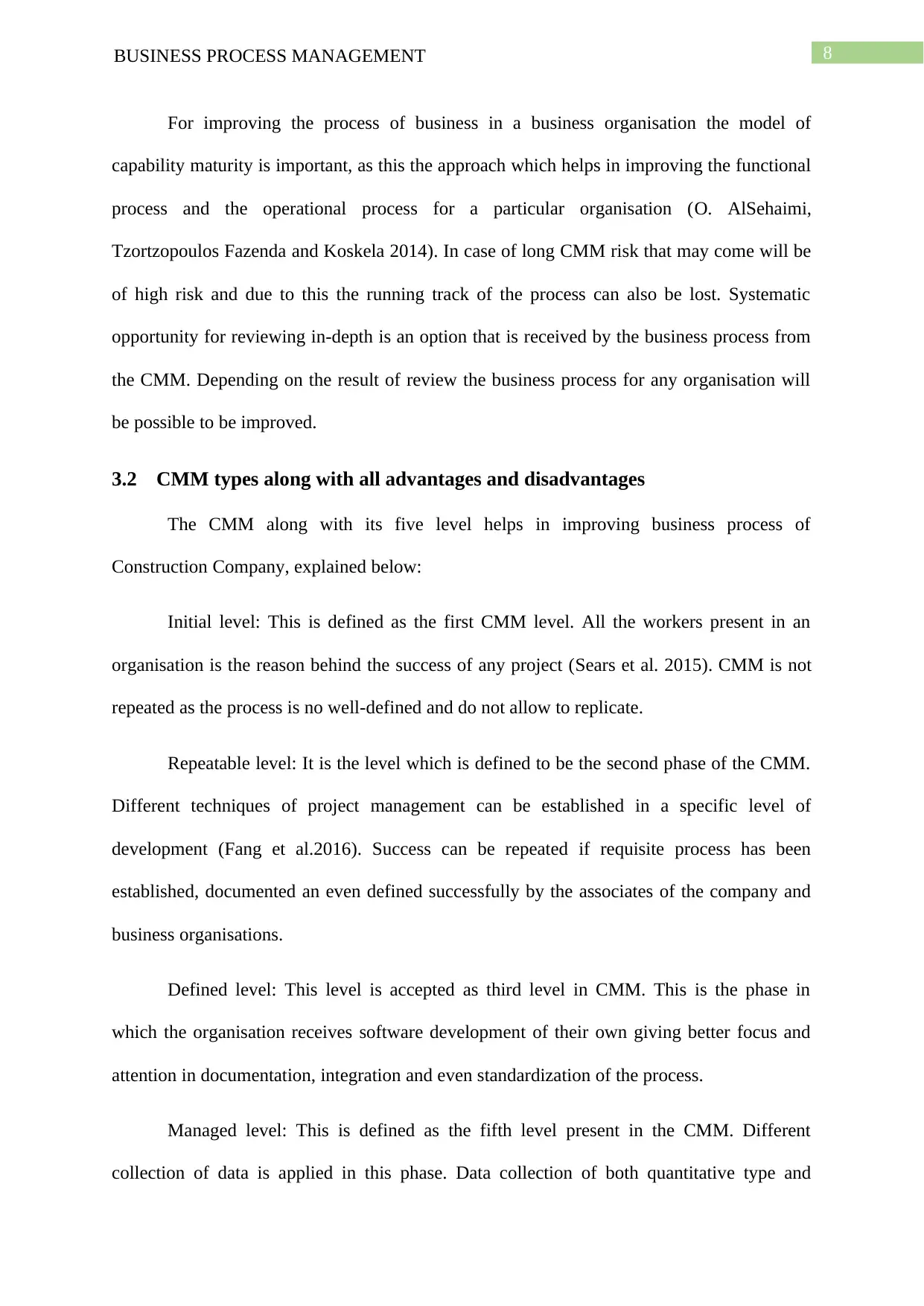
8BUSINESS PROCESS MANAGEMENT
For improving the process of business in a business organisation the model of
capability maturity is important, as this the approach which helps in improving the functional
process and the operational process for a particular organisation (O. AlSehaimi,
Tzortzopoulos Fazenda and Koskela 2014). In case of long CMM risk that may come will be
of high risk and due to this the running track of the process can also be lost. Systematic
opportunity for reviewing in-depth is an option that is received by the business process from
the CMM. Depending on the result of review the business process for any organisation will
be possible to be improved.
3.2 CMM types along with all advantages and disadvantages
The CMM along with its five level helps in improving business process of
Construction Company, explained below:
Initial level: This is defined as the first CMM level. All the workers present in an
organisation is the reason behind the success of any project (Sears et al. 2015). CMM is not
repeated as the process is no well-defined and do not allow to replicate.
Repeatable level: It is the level which is defined to be the second phase of the CMM.
Different techniques of project management can be established in a specific level of
development (Fang et al.2016). Success can be repeated if requisite process has been
established, documented an even defined successfully by the associates of the company and
business organisations.
Defined level: This level is accepted as third level in CMM. This is the phase in
which the organisation receives software development of their own giving better focus and
attention in documentation, integration and even standardization of the process.
Managed level: This is defined as the fifth level present in the CMM. Different
collection of data is applied in this phase. Data collection of both quantitative type and
For improving the process of business in a business organisation the model of
capability maturity is important, as this the approach which helps in improving the functional
process and the operational process for a particular organisation (O. AlSehaimi,
Tzortzopoulos Fazenda and Koskela 2014). In case of long CMM risk that may come will be
of high risk and due to this the running track of the process can also be lost. Systematic
opportunity for reviewing in-depth is an option that is received by the business process from
the CMM. Depending on the result of review the business process for any organisation will
be possible to be improved.
3.2 CMM types along with all advantages and disadvantages
The CMM along with its five level helps in improving business process of
Construction Company, explained below:
Initial level: This is defined as the first CMM level. All the workers present in an
organisation is the reason behind the success of any project (Sears et al. 2015). CMM is not
repeated as the process is no well-defined and do not allow to replicate.
Repeatable level: It is the level which is defined to be the second phase of the CMM.
Different techniques of project management can be established in a specific level of
development (Fang et al.2016). Success can be repeated if requisite process has been
established, documented an even defined successfully by the associates of the company and
business organisations.
Defined level: This level is accepted as third level in CMM. This is the phase in
which the organisation receives software development of their own giving better focus and
attention in documentation, integration and even standardization of the process.
Managed level: This is defined as the fifth level present in the CMM. Different
collection of data is applied in this phase. Data collection of both quantitative type and
⊘ This is a preview!⊘
Do you want full access?
Subscribe today to unlock all pages.

Trusted by 1+ million students worldwide
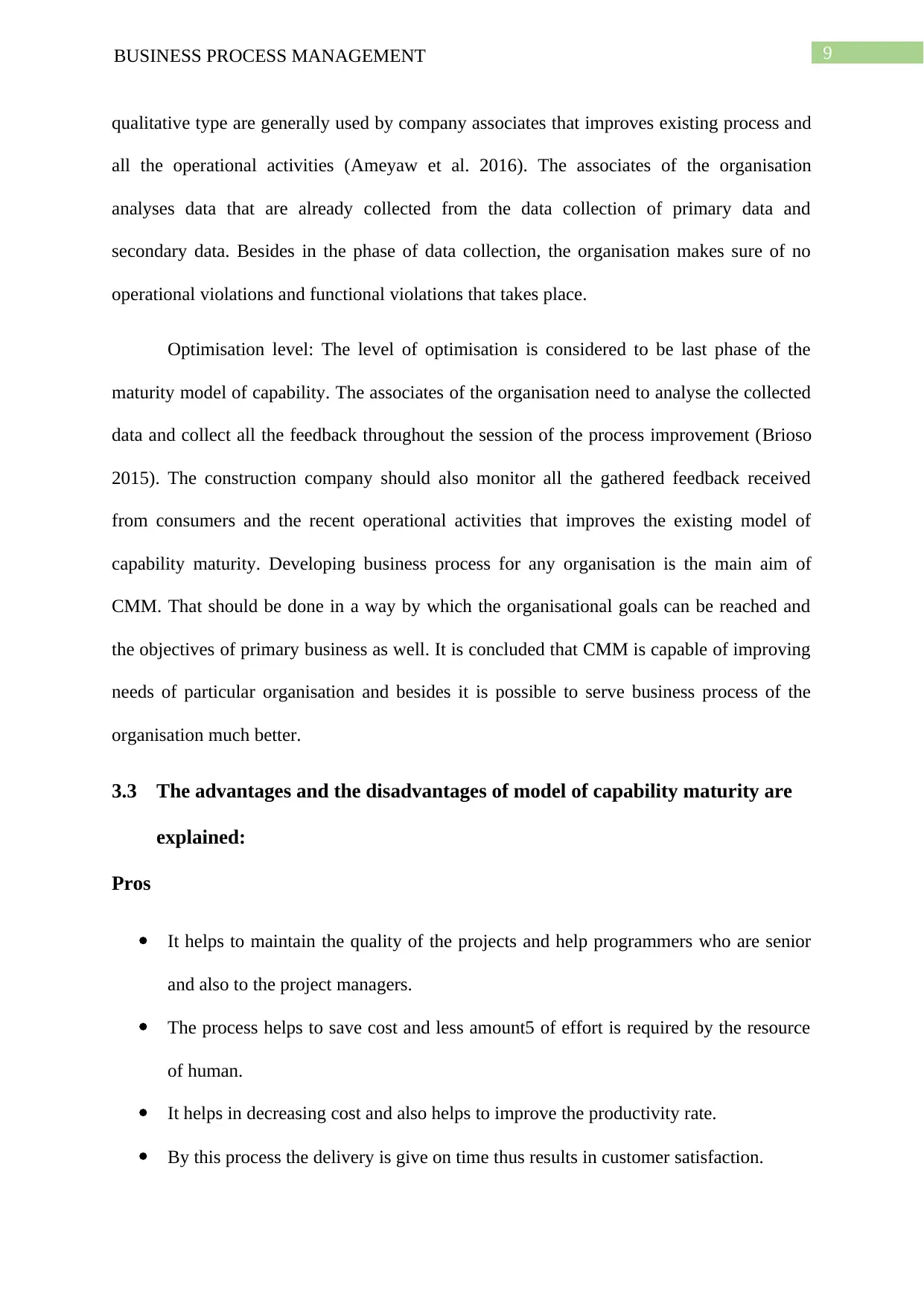
9BUSINESS PROCESS MANAGEMENT
qualitative type are generally used by company associates that improves existing process and
all the operational activities (Ameyaw et al. 2016). The associates of the organisation
analyses data that are already collected from the data collection of primary data and
secondary data. Besides in the phase of data collection, the organisation makes sure of no
operational violations and functional violations that takes place.
Optimisation level: The level of optimisation is considered to be last phase of the
maturity model of capability. The associates of the organisation need to analyse the collected
data and collect all the feedback throughout the session of the process improvement (Brioso
2015). The construction company should also monitor all the gathered feedback received
from consumers and the recent operational activities that improves the existing model of
capability maturity. Developing business process for any organisation is the main aim of
CMM. That should be done in a way by which the organisational goals can be reached and
the objectives of primary business as well. It is concluded that CMM is capable of improving
needs of particular organisation and besides it is possible to serve business process of the
organisation much better.
3.3 The advantages and the disadvantages of model of capability maturity are
explained:
Pros
It helps to maintain the quality of the projects and help programmers who are senior
and also to the project managers.
The process helps to save cost and less amount5 of effort is required by the resource
of human.
It helps in decreasing cost and also helps to improve the productivity rate.
By this process the delivery is give on time thus results in customer satisfaction.
qualitative type are generally used by company associates that improves existing process and
all the operational activities (Ameyaw et al. 2016). The associates of the organisation
analyses data that are already collected from the data collection of primary data and
secondary data. Besides in the phase of data collection, the organisation makes sure of no
operational violations and functional violations that takes place.
Optimisation level: The level of optimisation is considered to be last phase of the
maturity model of capability. The associates of the organisation need to analyse the collected
data and collect all the feedback throughout the session of the process improvement (Brioso
2015). The construction company should also monitor all the gathered feedback received
from consumers and the recent operational activities that improves the existing model of
capability maturity. Developing business process for any organisation is the main aim of
CMM. That should be done in a way by which the organisational goals can be reached and
the objectives of primary business as well. It is concluded that CMM is capable of improving
needs of particular organisation and besides it is possible to serve business process of the
organisation much better.
3.3 The advantages and the disadvantages of model of capability maturity are
explained:
Pros
It helps to maintain the quality of the projects and help programmers who are senior
and also to the project managers.
The process helps to save cost and less amount5 of effort is required by the resource
of human.
It helps in decreasing cost and also helps to improve the productivity rate.
By this process the delivery is give on time thus results in customer satisfaction.
Paraphrase This Document
Need a fresh take? Get an instant paraphrase of this document with our AI Paraphraser
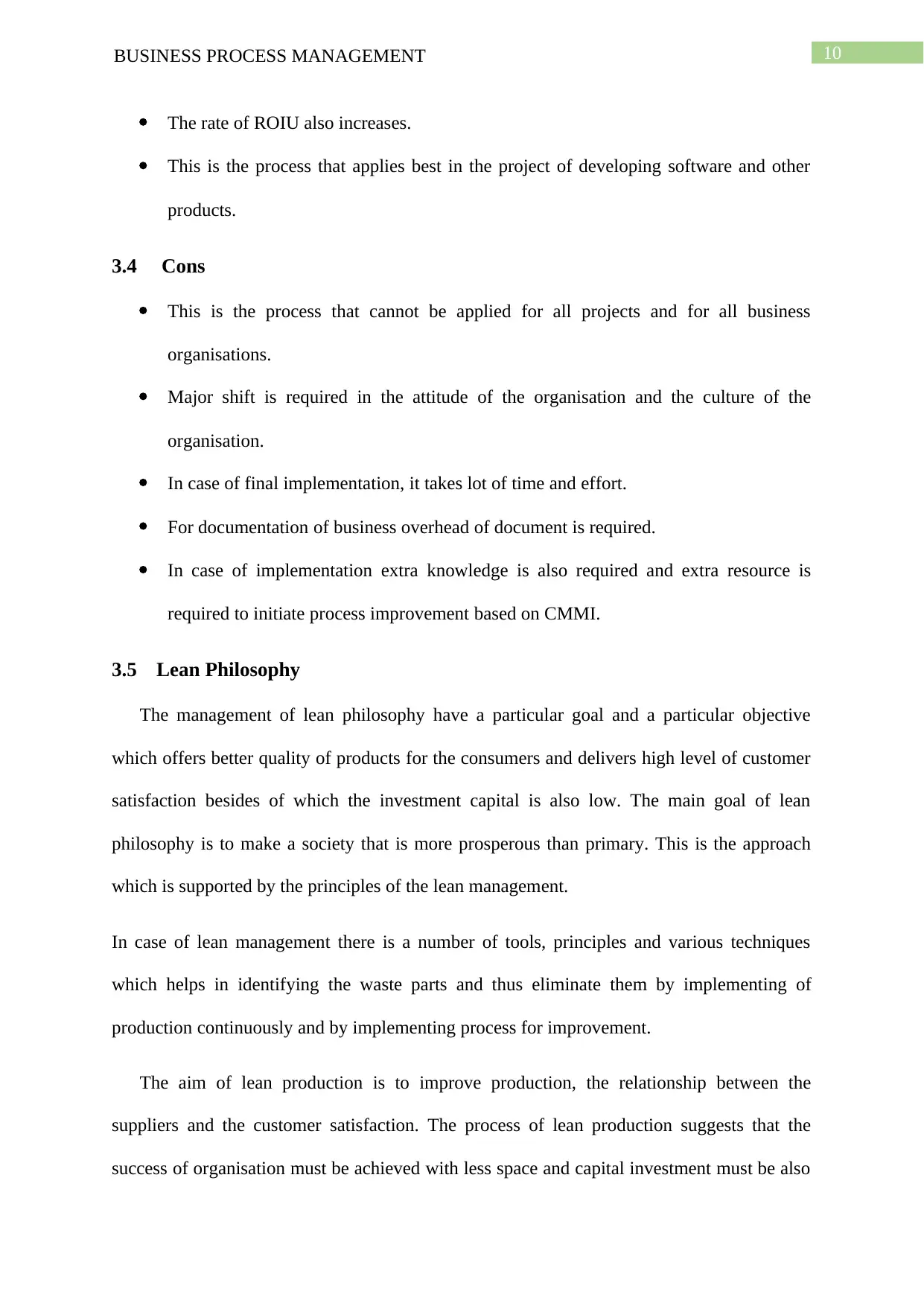
10BUSINESS PROCESS MANAGEMENT
The rate of ROIU also increases.
This is the process that applies best in the project of developing software and other
products.
3.4 Cons
This is the process that cannot be applied for all projects and for all business
organisations.
Major shift is required in the attitude of the organisation and the culture of the
organisation.
In case of final implementation, it takes lot of time and effort.
For documentation of business overhead of document is required.
In case of implementation extra knowledge is also required and extra resource is
required to initiate process improvement based on CMMI.
3.5 Lean Philosophy
The management of lean philosophy have a particular goal and a particular objective
which offers better quality of products for the consumers and delivers high level of customer
satisfaction besides of which the investment capital is also low. The main goal of lean
philosophy is to make a society that is more prosperous than primary. This is the approach
which is supported by the principles of the lean management.
In case of lean management there is a number of tools, principles and various techniques
which helps in identifying the waste parts and thus eliminate them by implementing of
production continuously and by implementing process for improvement.
The aim of lean production is to improve production, the relationship between the
suppliers and the customer satisfaction. The process of lean production suggests that the
success of organisation must be achieved with less space and capital investment must be also
The rate of ROIU also increases.
This is the process that applies best in the project of developing software and other
products.
3.4 Cons
This is the process that cannot be applied for all projects and for all business
organisations.
Major shift is required in the attitude of the organisation and the culture of the
organisation.
In case of final implementation, it takes lot of time and effort.
For documentation of business overhead of document is required.
In case of implementation extra knowledge is also required and extra resource is
required to initiate process improvement based on CMMI.
3.5 Lean Philosophy
The management of lean philosophy have a particular goal and a particular objective
which offers better quality of products for the consumers and delivers high level of customer
satisfaction besides of which the investment capital is also low. The main goal of lean
philosophy is to make a society that is more prosperous than primary. This is the approach
which is supported by the principles of the lean management.
In case of lean management there is a number of tools, principles and various techniques
which helps in identifying the waste parts and thus eliminate them by implementing of
production continuously and by implementing process for improvement.
The aim of lean production is to improve production, the relationship between the
suppliers and the customer satisfaction. The process of lean production suggests that the
success of organisation must be achieved with less space and capital investment must be also
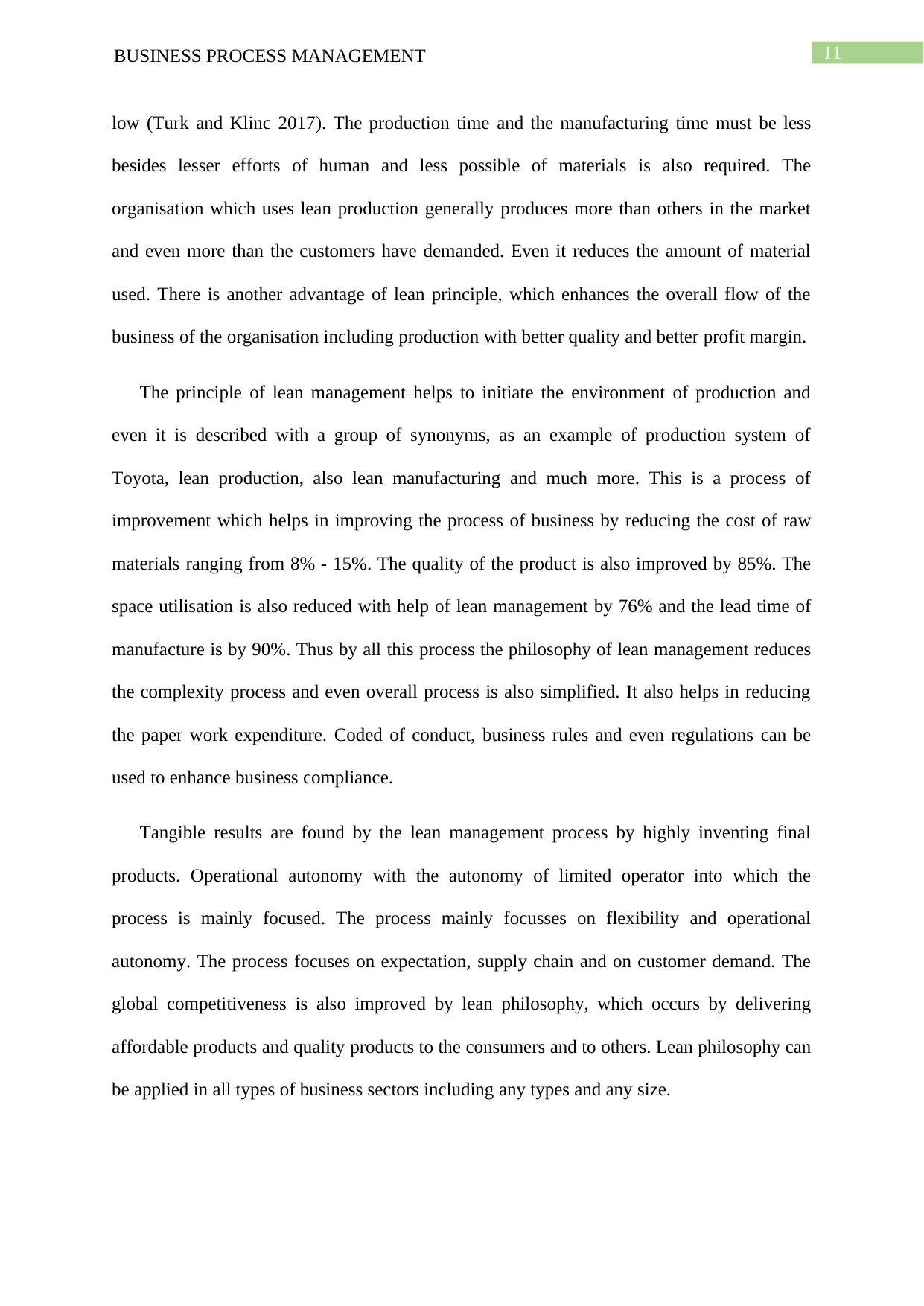
11BUSINESS PROCESS MANAGEMENT
low (Turk and Klinc 2017). The production time and the manufacturing time must be less
besides lesser efforts of human and less possible of materials is also required. The
organisation which uses lean production generally produces more than others in the market
and even more than the customers have demanded. Even it reduces the amount of material
used. There is another advantage of lean principle, which enhances the overall flow of the
business of the organisation including production with better quality and better profit margin.
The principle of lean management helps to initiate the environment of production and
even it is described with a group of synonyms, as an example of production system of
Toyota, lean production, also lean manufacturing and much more. This is a process of
improvement which helps in improving the process of business by reducing the cost of raw
materials ranging from 8% - 15%. The quality of the product is also improved by 85%. The
space utilisation is also reduced with help of lean management by 76% and the lead time of
manufacture is by 90%. Thus by all this process the philosophy of lean management reduces
the complexity process and even overall process is also simplified. It also helps in reducing
the paper work expenditure. Coded of conduct, business rules and even regulations can be
used to enhance business compliance.
Tangible results are found by the lean management process by highly inventing final
products. Operational autonomy with the autonomy of limited operator into which the
process is mainly focused. The process mainly focusses on flexibility and operational
autonomy. The process focuses on expectation, supply chain and on customer demand. The
global competitiveness is also improved by lean philosophy, which occurs by delivering
affordable products and quality products to the consumers and to others. Lean philosophy can
be applied in all types of business sectors including any types and any size.
low (Turk and Klinc 2017). The production time and the manufacturing time must be less
besides lesser efforts of human and less possible of materials is also required. The
organisation which uses lean production generally produces more than others in the market
and even more than the customers have demanded. Even it reduces the amount of material
used. There is another advantage of lean principle, which enhances the overall flow of the
business of the organisation including production with better quality and better profit margin.
The principle of lean management helps to initiate the environment of production and
even it is described with a group of synonyms, as an example of production system of
Toyota, lean production, also lean manufacturing and much more. This is a process of
improvement which helps in improving the process of business by reducing the cost of raw
materials ranging from 8% - 15%. The quality of the product is also improved by 85%. The
space utilisation is also reduced with help of lean management by 76% and the lead time of
manufacture is by 90%. Thus by all this process the philosophy of lean management reduces
the complexity process and even overall process is also simplified. It also helps in reducing
the paper work expenditure. Coded of conduct, business rules and even regulations can be
used to enhance business compliance.
Tangible results are found by the lean management process by highly inventing final
products. Operational autonomy with the autonomy of limited operator into which the
process is mainly focused. The process mainly focusses on flexibility and operational
autonomy. The process focuses on expectation, supply chain and on customer demand. The
global competitiveness is also improved by lean philosophy, which occurs by delivering
affordable products and quality products to the consumers and to others. Lean philosophy can
be applied in all types of business sectors including any types and any size.
⊘ This is a preview!⊘
Do you want full access?
Subscribe today to unlock all pages.

Trusted by 1+ million students worldwide
1 out of 24
Related Documents
Your All-in-One AI-Powered Toolkit for Academic Success.
+13062052269
info@desklib.com
Available 24*7 on WhatsApp / Email
![[object Object]](/_next/static/media/star-bottom.7253800d.svg)
Unlock your academic potential
Copyright © 2020–2025 A2Z Services. All Rights Reserved. Developed and managed by ZUCOL.





